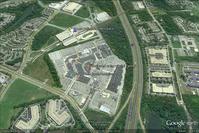Cafritz project tests Prince George’s commitment to TOD

Boulevard at Cap Centre, a better site for this development. Image from Google Earth
The owners of the Cafritz property in Riverdale Park want a zoning change to build a major mixed-use development on a wooded, 37-acre single-family-zoned property with, at best, mediocre access to transit. If Prince George’s County is serious about its commitment to smart growth and development around its 15 Metro stations, it will deny the rezoning.
In recent years, Prince George’s has repeatedly rezoned low-density sites with poor transit access all around the county, such as the Westphalia and Konterra mega-projects.
The county is desperate to attract high-quality mixed-use development, but all too often, this desperation leads it to act against its own best interests. Each time the county allows a huge project in any arbitrary location, it becomes less likely that the right kind of development will come to the Metro sites.
The Cafritz owners want to build 2 million square feet of mixed-use commercial, residential, and hotel space, including a Whole Foods Market. Building the retail there would make stores less likely to locate at other sites which are closer to transit and already zoned for high-density mixed-use development, like the Boulevard at Capital Centre near the Largo Town Center Metro, University Town Center at Prince George’s Plaza, or Arts District Hyattsville.
On February 2, the Prince George’s County Planning Board of the Maryland-National Capital Park and Planning Commission (M-NCPPC) will resume its deliberations over whether to recommend the rezoning to the County Council. The County Council will then hold a second public hearing and receive additional public comments before deciding whether to rezone the property.
Recently, I argued that the Boulevard at Capital Centre is a better location for the Whole Foods and the rest of the project. Alex Block argued, “Metro isn’t the be-all and end-all of transit. The [Cafritz] project is a perfectly reasonable infill development site.”
The Cafritz property site may indeed be perfectly reasonable for some kind of infill development, such as a suburban residential subdivision of 200 homes with some limited “corner store”-type convenience retail. But 2 million square feet of development, including 995 housing units and more than 370,000 square feet of retail, office, and hotel space, is not a reasonable infill project for that location. That’s more than 4 times the size of the current development at the Boulevard at Cap Centre, near a Metro station.
Without excellent existing transit options, this much development will induce a disastrous amount of auto traffic. Even the Planning Board staff says the traffic generated by this proposed development will exceed countywide master plan of transportation vehicle limits for the US-1/East-West Highway area. (See pp. 33-36 of the staff report.)
Meanwhile, the 69-acre Boulevard site can easily accommodate the level of development proposed for Cafritz Property. It’s also already zoned for high-density mixed use development. In fact, the county’s 2002 General plan designated the Largo Town Center station area as a “Metropolitan Center,” suitable for the most intensive “downtown-style” development in the county. The county Revenue Authority owns the Boulevard site, so it could easily facilitate this development.
The Boulevard site is already cleared, so developing there would not require further deforestation and could even improve stormwater treatment by replacing the existing sea of surface parking with buildings and additional trees. The Largo Town Center Metro would absorb more of the travel demand, and deevlopment here would be more consistent with the county’s master plan of transportation and with smart growth principles generally.
Besides taking retail and housing demand away from potential Metro sites, the Caftitz project could detract from nearby mixed-use projects already in progress. The brand-new 25-acre Arts District Hyattsville development is just 1 mile south of the Cafritz site. Although construction is still underway on the first phase of that development, the entire project will eventually have 500 housing units and 40,000 SF of commercial space when completed.
Similarly, about 1.3 miles to the west of the Cafritz site, near Prince George’s Plaza Metro Station, sits the 56-acre University Town Center development. Construction began in earnest on that site in the 1990s and was really beginning to gain momentum in the mid-2000s, until the economy tanked. Recently, several buildings in that development were foreclosed upon and are being held by Wells Fargo, until the original developer can recover or a new owner is found.
There is still oodles of space remaining at UTC for high-density mixed-use residential and commercial development of the type proposed for the Cafritz site, without the need for any zoning changes or clearing of wooded land. Furthermore, UTC is within a half-mile of a Metro station and can accommodate any additional need for high-density retail, residential, and commercial development in the surrounding retail market area, which includes nearby Riverdale Park.
Before authorizing the up-zoning of new greenfield sites like the Cafritz property, the county should insist that developers maximize the development potential at existing Metro stations, such as the Boulevard at Cap Centre or University Town Center, or at existing inner-Beltway mixed use projects like Arts District Hyattsville. If Prince George’s County is going to be successful in attracting the type of quality investment and development it says it wants around its Metro stations, its leaders have to be disciplined about following the county’s comprehensive land use policies.
The county can’t keep approving the wrong type of development in the wrong locations just because a particular property owner or developer wants it. It would be great for the county to gain 2 million square feet of high-quality transit-oriented development, but that needs to happen at the Largo Town Center Metro or one of the other existing Metro station areas in need of such high-intensity development.
